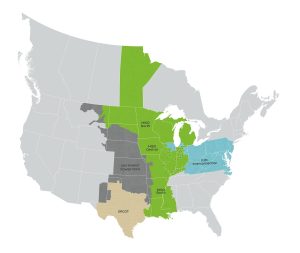Most load serving entities are now realizing that planning for the winter months becomes more of a challenge. With the new requirements for the winter, the reserve margins are a lot higher than before.
Matt Moore
Executive Vice President, Power Supply
Wabash Valley Power
Wabash Valley Power Alliance has transformed how it plans to meet energy demands to account for more renewable resources such as solar and wind powering the energy grid.
The Midcontinent Independent System Operator, which manages high-voltage electricity transmission in 15 central U.S. states and Manitoba in Canada, updated planning requirements for electricity providers to ensure that they can fulfill consumers’ energy needs. MISO now requires electricity providers to plan to meet their peak demand for each season of the year, along with a larger reserve margin requirement in the winter. Electricity providers previously planned resources to meet their summer demand peak of the year. WVPA, which provides wholesale power for more than 20 electric distribution cooperatives in MISO territory, traditionally experiences its highest demand in the summer. MISO implemented the changes to account for the increasing amount of electricity generated by renewable resources such as wind and solar energy.

MISO is a regional transmission operator that manages high-voltage electricity transmission in 15 central U.S. states and Manitoba in Canada. MISO’s service territory is shaded green in this map.
“MISO is recognizing that each season has its own characteristics, in terms of load and demand, as well as the fleet generating electricity,” said Vicki Myers, manager of power supply for Wabash Valley Power. “The organization wants to plan for the variance in demand and make sure that the generation fleet can appropriately meet the need for each season as well.”
While renewables are appealing because they do not have carbon emissions, they generate electricity depending on conditions that fluctuate significantly during the time of day or even year. Coal and natural gas power plants can generate electricity as needed; some run up to 24 hours per day.
MISO also changed the electricity generation capacity credit based on renewable resources’ ability to produce energy during different seasons. Previously, electricity providers received annual capacity credit for solar resources based only on their summer production. Solar arrays generate much less electricity in the winter than summer; in MISO’s new construct, solar arrays receive more capacity credit in summer than winter, said Matt Moore, executive vice president for power supply with Wabash Valley Power. Windmills generate more electricity in the winter than summer, which he noted MISO also accounts for in its new model.
The regional transmission operator also now requires electricity providers to have the capacity to generate more than 25 percent of the anticipated peak energy demand in winter to account for unexpected demand spikes during snowstorms or extreme cold, Moore said.
“Most load serving entities are now realizing that planning for the winter months becomes more of a challenge,” he added. “With the new requirements for the winter, the reserve margins are a lot higher than before.”
MISO implemented the new seasonal requirements for the planning resource auction in April. The auction takes place each spring for the planning year (June 1-May 31) and provides an opportunity for electricity providers in MISO to ensure that they can meet their projected energy needs.
Wabash Valley Power plans for long-term energy needs for its member cooperatives and the families and businesses they serve. WVPA continues to explore additional options, such as battery storage, that also can help increase the efficiency of renewable energy resources. The batteries can potentially store excess electricity generated by windmills and solar arrays, and then be discharged onto the grid when needed.
“We are committed to the safe delivery of reliable, affordable electricity to all those we serve,” said Jeff Conrad, president and CEO of Wabash Valley Power. “We continue to work diligently with our member cooperatives to achieve that goal. The developments and changes we have experienced with technology also provide unique opportunities to better serve our communities. We are excited as we plan for the future.”

